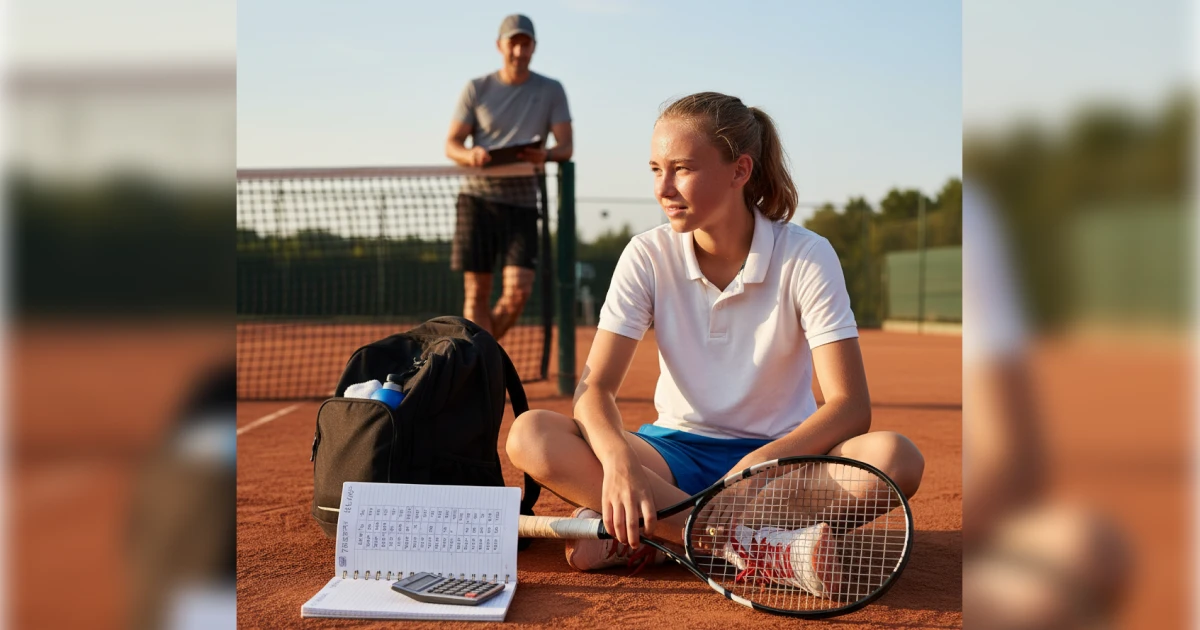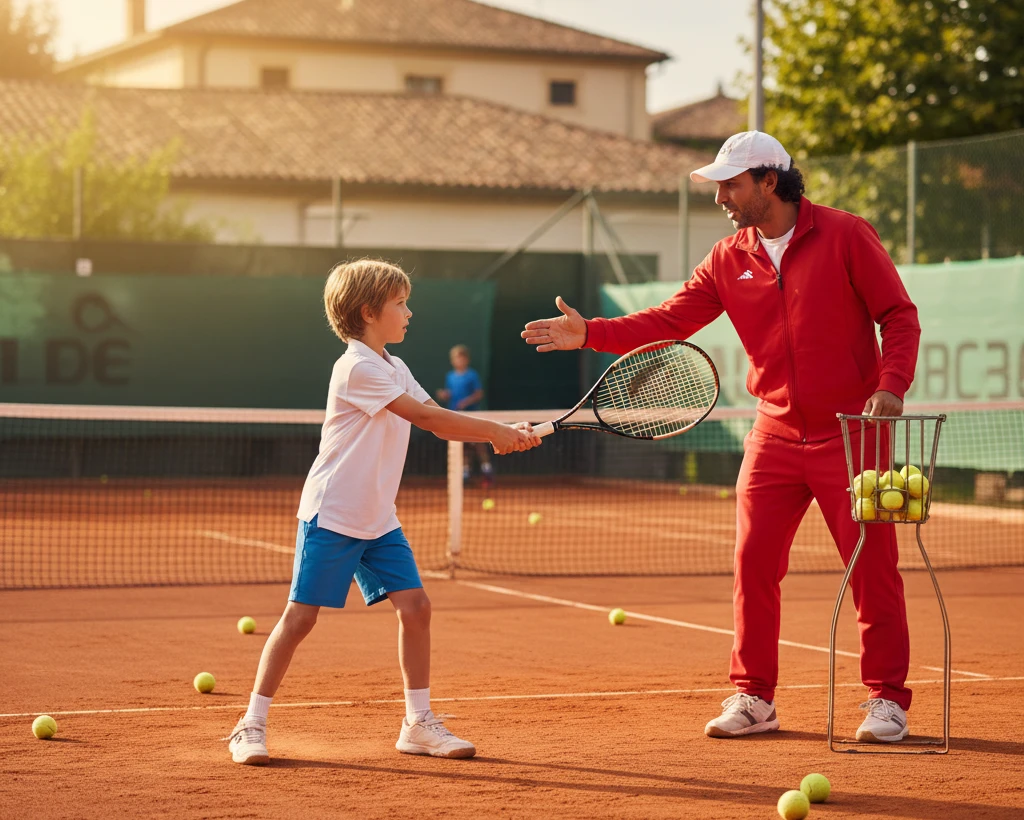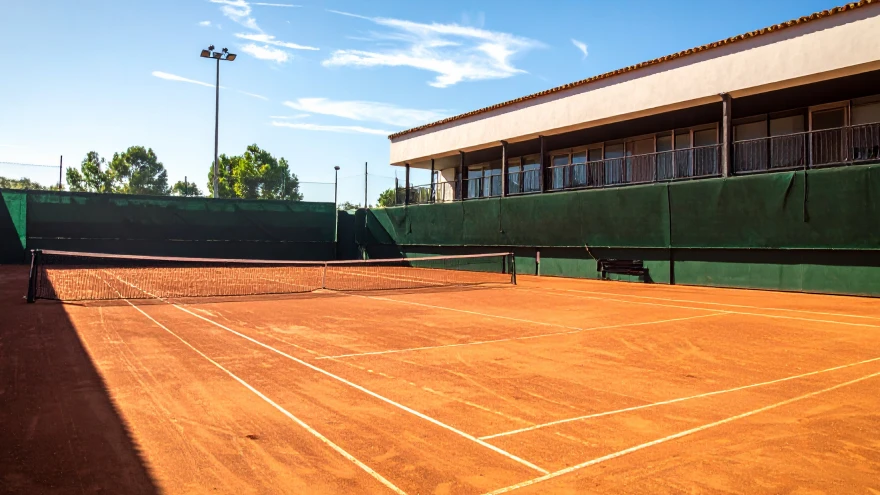The Complete 10-Year Pathway for Junior Tennis Players
Discover the complete 10-year pathway for junior tennis players, from age 8 to college or pro. Learn benchmarks, academy guidance, training tips, and tournament planning.
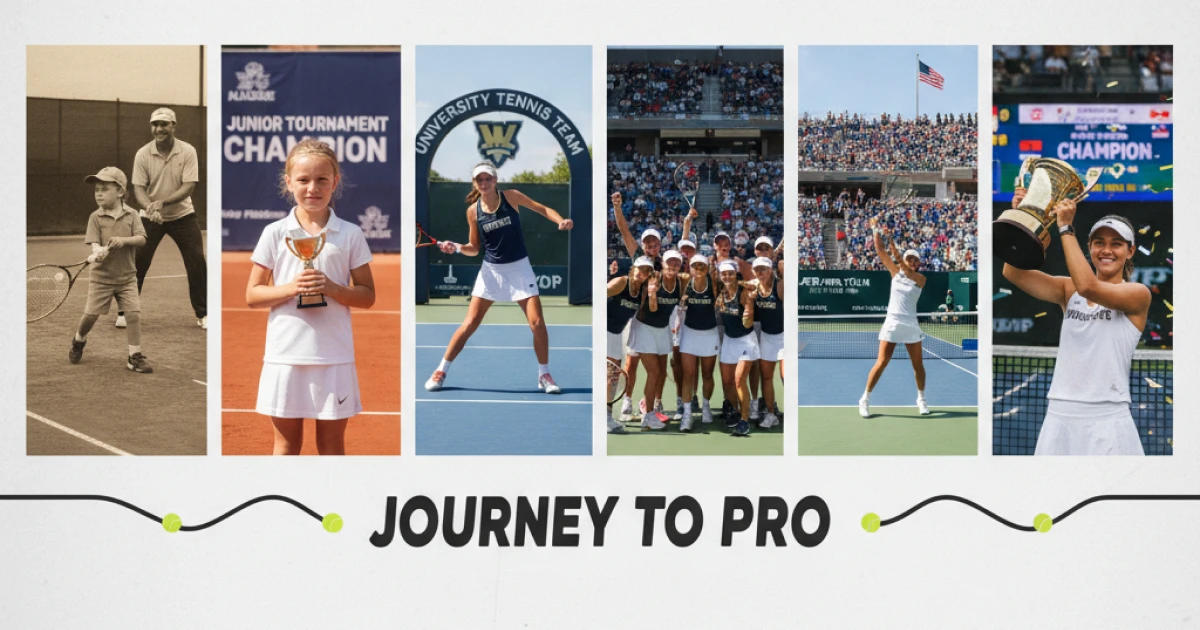
The Complete 10-Year Pathway for Junior Tennis Players: From 8 Years Old to College or Pro
Every successful professional tennis player, from Carlos Alcaraz to Coco Gauff, once faced the same question parents and juniors ask today: What’s the right long-term pathway? Planning a 10-year journey — from first rallies to college or pro competition — helps families set realistic benchmarks, choose the right academy environment, and avoid burnout. This guide, built on evidence from the ITF Coaching & Sport Science Review and LTAD (Long-Term Athlete Development) research, outlines every stage clearly.
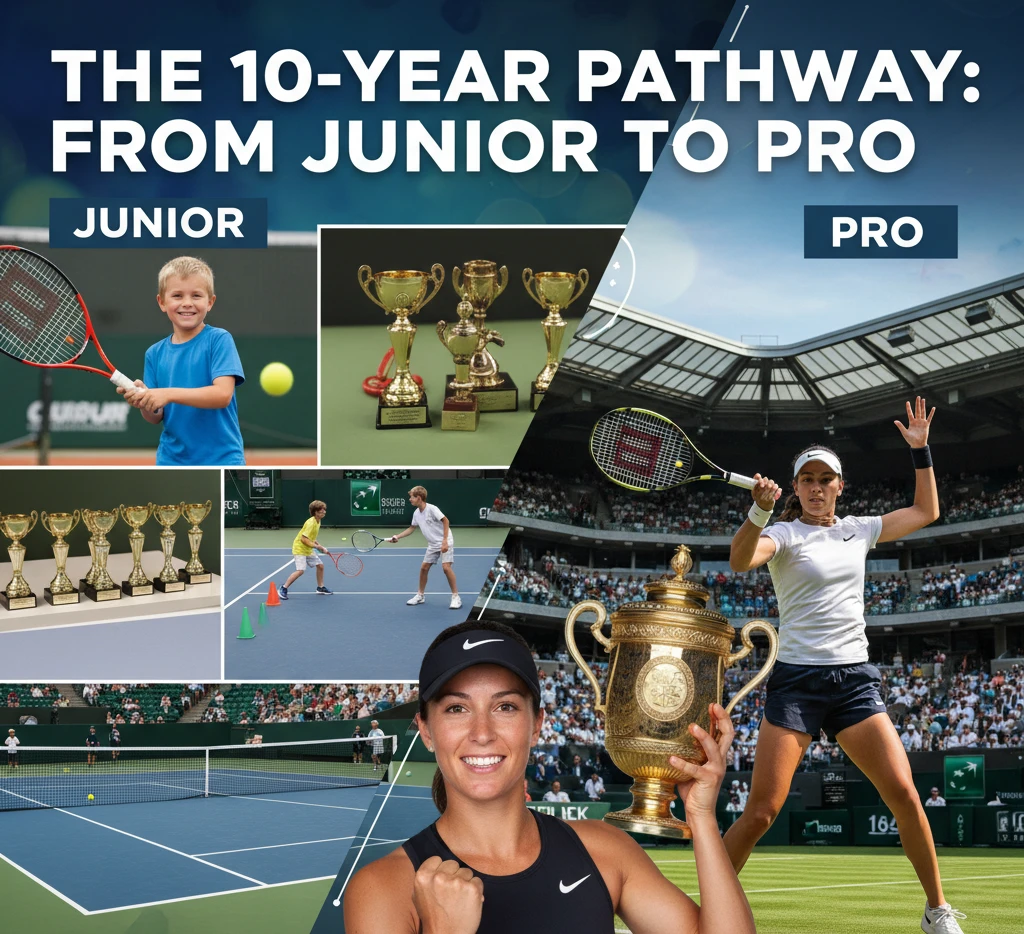
Why a Long-Term Pathway Matters
Most juniors quit before age 15 — not for lack of talent, but because of misaligned expectations. A decade-long plan lets families track progress, measure key metrics, and balance school, travel, and recovery. It transforms tennis from a seasonal activity into a guided development project.
- Consistency beats intensity — steady technical growth prevents overuse injuries.
- Evidence-based benchmarks — objective markers (serve speed, UTR, ranking) replace guesswork.
- Informed academy choice — knowing when to switch from local coaching to a tennis academy prevents premature moves.
Overview of the 10-Year Framework
The pathway divides into five key stages:
- Ages 8-10 — Engagement & Fundamentals
- Ages 11-13 — Skill Consolidation & Competitive Intro
- Ages 14-16 — Academy Immersion & Performance Transition
- Ages 17-19 — Pathway to College or Pro
- Age 20 + — Early Career Management & Senior Transition
Each phase integrates physical, technical, tactical, and psychological benchmarks. Internal links point you to deeper guides — like Training Tips and Mental Toughness in Tennis — for focused improvement.
Stage 1 ( Ages 8-10 ): Engagement & Fundamentals
Objectives
At this early age, the mission is simple: fall in love with the sport. Coordination, balance, and motivation outweigh competitive results. Research from the LTAD Tennis-Specific Model (Tennis Canada) recommends multi-sport play, small-court formats, and fun-based learning.
Key Benchmarks
- Rally 8–10 balls consistently from baseline.
- Serve and return with correct grip fundamentals (continental + semi-western).
- Exhibit agility & balance in movement to ball.
Recommended Activities
Parents should focus on engagement over performance. Weekend match-play, local red/orange/green-ball circuits, and holiday programs like TennisDex Summer Camps are ideal. Coaches introduce pre-hab drills using bands or mini-hurdles to develop motor patterns safely.
Physical & Cognitive Focus
At this age, cognitive plasticity peaks. Keep instruction concise, use metaphors (“catch the ball in the strings”), and integrate dual-task challenges to link mind-body coordination. Strength training should remain body-weight only.
“Fun and variety predict long-term retention better than early specialization.” — ITF Player Development Report 2024
Stage 2 ( Ages 11-13 ): Skill Consolidation & Competitive Intro
This phase bridges playful tennis and structured performance. It’s when players often move from local coaching to part-time academies or regional centers. Cognitive maturity enables tactical awareness; physically, growth spurts demand careful load management.
Technical & Tactical Goals
- Refine serve mechanics (pre-toss consistency, rhythm, knee bend).
- Develop pattern recognition — “serve + first ball,” “cross + line.”
- Learn to control court position and shot selection under pressure.
Tournament Planning
Begin national U12 or U14 events, aiming for 20–25 competitive matches per year. Introduce match analysis logs to record first-serve %, unforced errors, and mental state between points.
Physical Development
Introduce foundational strength (bands, med-balls, body control). According to ITF Coaching & Sport Science Review No. 84, coordination + core stability correlate with serve velocity and injury prevention in youth players.
Mental Resilience
Many players face their first real defeats here. Introduce mindfulness and simple pre-point routines like breathing and cue words.
Stage 3 ( Ages 14-16 ): Academy Immersion & Performance Transition
By this stage, players enter serious development territory. The goal shifts from learning skills to executing them under competitive stress. Many families choose a dedicated academy environment — often abroad in Europe — to gain access to higher-level sparring, sports science, and international tournaments.
Choosing the Right Academy
Start by comparing institutions through the TennisDex Academies Directory. Assess three critical pillars:
- Coaching Quality — ITF-certified staff with player progress metrics and individual plans.
- Training Volume vs Load Management — 20-25 hrs/week on-court + 4-6 hrs S&C, with scheduled recovery.
- Academic Support — flexible curricula (e.g., online IB or US homeschool models) to balance education.
For a comprehensive checklist and cost ranges, read our feature Complete Guide to Costs & Fees for European Tennis Academies (2025 Edition).
Performance Metrics to Track
- Serve speed target: 160–175 km/h (men), 130–150 km/h (women)
- First-serve % > 60 %
- Break-point conversion > 35 %
- Training volume: 25–30 hrs/week (inc. fitness)
External Learning Resources
Deepen understanding with resources like the ITF Coaching & Sport Science Review and the LTAD Research for Tennis (ResearchGate). Both highlight the importance of longitudinal tracking and sport-science integration.
Stage 4 ( Ages 17–19 ): Pathway to College or Professional Tennis
At this point, a player’s identity as an athlete solidifies. Technical corrections narrow, tournament scheduling becomes international, and strategic career decisions emerge: college or pro? Understanding both routes — and their long-term implications — is essential for sustainability.
Dual-Career Decision Matrix
Families and coaches should evaluate five dimensions before committing to a pathway:
- Ranking Trajectory: Has the player achieved a competitive UTR (11+ for men, 9+ for women) and ITF Junior ranking?
- Financial Viability: College tennis provides scholarships; the professional path requires funding of $50–100k / year for travel and coaching.
- Academy Ecosystem: Programs like TennisDex-listed academies now partner with NCAA and European universities to combine education with high-level training.
- Psychological Readiness: Independence, time management, and resilience become key differentiators.
- Long-Term Athletic Development (LTAD) Fit: The ITF Coaching & Sport Science Review emphasizes that late physical maturation does not preclude elite performance — patience pays off.
College Tennis Path
College tennis offers elite facilities, analytics, and strength programs while maintaining academic progress. Top NCAA programs integrate GPS load monitoring, match video analysis, and personalized sport psychology sessions. For guidance on applying to universities with strong tennis programs, see our Academy News section.
Professional Path
Players targeting the professional circuit enter ITF M15/M25 tournaments to accumulate points. Focus shifts to periodization, physiotherapy, and mental conditioning. Partnering with data-driven academies (see AI for Equitable Tennis Training) provides performance tracking and predictive analytics.
Key Performance Indicators (KPIs)
- Serve speed target: 185 km/h (men) / 160 km/h (women)
- First-serve %: > 65 %
- Break-point conversion > 40 %
- Match-to-practice ratio: 1 : 5
- Strength-to-weight ratio: 1.8× bodyweight squat (men), 1.2× (women)
Stage 5 ( Age 20 + ): Early Career Management & Senior Transition
The shift from junior or college competition into senior tours introduces fresh challenges: sponsorship, scheduling, and injury prevention. Many players underestimate the value of off-court strategy.
Career Planning
- Collaborate with mentors or sports agents familiar with ITF and ATP/WTA entry systems.
- Map a 12-month calendar balancing tournament density with recovery blocks.
- Leverage analytics dashboards from partner academies or wearable devices to prevent overtraining.
Sport Science Integration
Sport-science research (see arXiv.org) underscores that data-driven load monitoring improves performance longevity. Recovery modalities — sleep tracking, HRV, and mobility screening — should be standard practice.
Lifestyle & Mental Resilience
Professional athletes succeed by creating sustainable routines. The Mental Toughness in Tennis guide covers visualization, journaling, and failure reframing techniques validated by sport psychologists.
Benchmarks & Metrics Table ( Age 8 → 20 + )
| Age Range | Primary Focus | Technical Benchmarks | Physical Targets | Competition Level | Training Hours / Week |
|---|---|---|---|---|---|
| 8–10 | Engagement & Fundamentals | Grip stability, rally 8–10 balls | Agility & coordination | Local Red/Orange Ball | 5–8 |
| 11–13 | Skill Consolidation | Serve mechanics + patterns | Intro to strength & core | National U12–U14 | 10–15 |
| 14–16 | Academy Immersion | Match strategy & analytics | Power & mobility balance | ITF Juniors | 25–30 |
| 17–19 | Transition to College/Pro | Serve speed 170 km/h + | Max strength & speed | National & International | 25–35 |
| 20 + | Career Management | Match consistency & tactics | Injury prevention focus | ATP/WTA Entry Level | 20–30 |
Benchmarks derived from ITF and Tennis Canada LTAD models (source).
How to Choose an Academy at Each Stage
Evaluation Checklist
- Coaching Credentials: ITF- or PTR-certified staff.
- Training Environment: Ratio ≤ 1:4 coach to player; indoor & outdoor courts.
- Sports Science Support: S&C coach, physio, nutritionist on-site.
- Academic Flexibility: Online schooling or IB integration.
- Culture & Values: Emphasis on character and sportsmanship.
Use the TennisDex Academies Directory to filter by country, price range, and training focus. Parents should also review the Complete Guide to Costs & Fees for European Tennis Academies (2025 Edition) for financial planning.
Common Red Flags
- No written individual development plans.
- Excessive hours without recovery monitoring.
- High player turnover or lack of academic coordination.
Case Studies / Player Journeys
Real-world pathways inspire and educate. Below are anonymized composite stories drawn from publicly available cases.
“Luca” – European Academy → NCAA Scholarship
Luca joined a Spanish academy at 15 after reaching national semifinals. By 18 he had a UTR of 12.2 and committed to a Division I U.S. program. His academy supported academic prep and helped secure recommendations — a model transition from Europe to college.
“Sara” – Early Pro Transition
Sara showed elite physical maturity by 16 and entered ITF M/W15 events while continuing studies online. Her coaches applied load monitoring using smart wearables, reducing injury risk by 35 %. At 19 she earned her first WTA points.
“Daniel” – Late Bloom Success
Daniel peaked physically late, joining a performance academy at 17. He focused on strength and serve development and by 21 became top-5 in his national ranking. His story reinforces LTAD principles: late development is not failure.
FAQs & Myths Debunked
“You must join an academy by age 12.”
False. While structured environments help, many top players (especially in Northern Europe and the U.S.) trained locally until 14–15 before joining academies. Timing depends on motivation and local competition quality.
“More hours mean faster progress.”
Volume without recovery leads to plateaus and injuries. The LTAD model emphasizes periodization and rest cycles over constant load. See our Training Tips section for smart scheduling templates.
“Serve speed equals future success.”
Not necessarily. According to the ITF Sport Science Review, movement efficiency and decision-making predict pro potential better than raw serve velocity.
“Academy training is too expensive for most families.”
Partial truth. Costs vary widely. Some academies offer scholarships or part-time boarding options. Explore the Academy Directory filters for budget-friendly alternatives and look into national federation support grants.
Conclusion & Call to Action
Creating a 10-year development plan is the single most valuable investment a parent or junior can make. By aligning expectations with research-based benchmarks and leveraging the right academy environment, players can maximize their potential while maintaining balance and joy in the sport.
Explore our full Tennis Academies Directory, discover upcoming Summer Camps, and read related guides on Training Tips and Mental Toughness in Tennis to map your next steps.
With clear benchmarks, open communication, and trusted resources, every junior player can navigate the path from first serve to college or pro career with confidence.
References & Further Reading
- Tennis Canada LTAD Model (PDF)
- ITF Coaching & Sport Science Review
- Wikipedia: Tennis Strategy
- ResearchGate: Long-Term Player Development in Tennis
© 2025 TennisDex — Helping Parents & Players Map the Journey from Junior to Pro.
